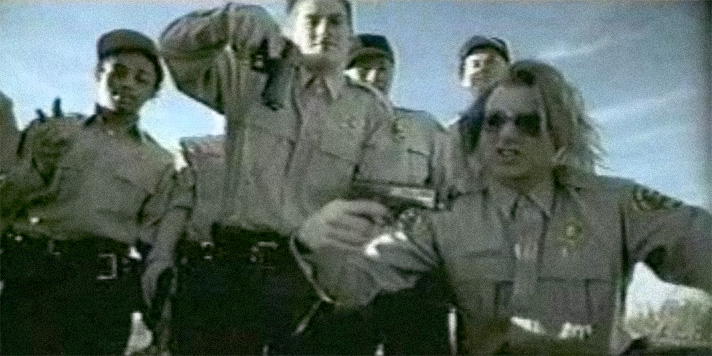
In Boogie Nights, Paul Thomas Anderson’s film about the porn industry of the 70s and 80s, Burt Reynolds’ Jack Horner gives a fateful speech admonishing the advent of home video: “I have a stable of actors and actresses. They’re professionals. They’re not a bunch of fucking amateurs. They’re proven in the box office. They get people in theaters, where films should be seen, and they know how to fuck.”
It is not hard to imagine similar tirades (maybe with a few words switched out) occurring in Powell-Peralta boardrooms as the 80s were coming to a close, and skateboarding was around the corner from a crash. Skate videos of the decade were refined and narrative-driven, and for good reason. There were only like, six tricks invented at the time, so they had to fill up those other 53 minutes in an hour-long skate video with story, personality shots and other shit.
But what would come after skateboarding’s believed-to-be demise was a rebirth. Videos like Snuff, Video Days, Tim & Henry’s Pack of Lies, and Questionable were unrepentant in their progression — they were too busy inventing modern skateboarding in front of your eyes to worry about the extracurricular malarky from the Animal Chin days. New faces and a camera thrown in a backpack was the name of the game. The old mode was dead. But for how long?
Skateboarding draws many parallels to pornography, but one of the most curious ones is an incessant need to add narrative to something that nobody watches for the story. As we will soon learn, plots returned to skate videos as quickly as they went.
Las Nueve Vidas De Paco (1995)
Director: Spike Jonze
Cinematic Spirit Animal: For A Few Dollars More (Sergio Leone, 1965)
In 1995, skateboarding was starting to boom again. Skaters looked around at each other, nodded, and acknowledged that they could use a breather from the five-plus years of people inventing dozens of tricks with each new video.
The freshly formed Chocolate Team asked Spike Jonze to create what American filmmakers do best when they romanticize our nation’s past, and that’s make a western. The team finds itself wandering destitute around the desert, thinking of ways to break their friend Paco, who had been wrongfully accused of mail fraud, out of police custody. Skaters’ long-form narrative chops were still rusty from a dormant period, and Nueve Vidas drags a lot, but it does introduce a motif of pretty much every skate video with a plot that proceeds it: violence against law enforcement. Gabriel Rodriguez shoots the corrupt sheriffs in the film’s closing scene, and [spoiler!] Paco, too.
The Chocolate Tour (1999)
Director: Spike Jonze
Cinematic Spirit Animal: The Blues Brothers (John Landis, 1980)
To be honest, it’s not easy to make fun of The Chocolate Tour, because it is still…good? And still makes you smile? And is still one of the best artifacts from the era?
Fun bit of trivia: the guy with the long hair MCing the first demo in the video would become the first skater to actually win an Academy Award ;)
Guilty (2001)
Director: Tony Buyalos
Cinematic Spirit Animal: Not really First Blood, but more like all the bad movies that tried to be First Blood throughout the Reagan administration.
You have heard of the sophomore jinx. And for people who began skating around Tony Hawk Pro Skater, Shorty’s debut video, Fulfill The Dream, holds a place that non-skater humans reserve in their hearts for first kisses and other touchstones of youth. Fans waited years for the sequel. And Shorty’s returned in 2001, only for us to learn that the team had been destroying property (obvi), assaulting officers (less obvi), and committing homicides (totally outta left field) since their last video. The judge lets Muska keep his shades and bandana on at the sentencing, and issues the death penalty for the entire Shorty’s team via firing squad. Antiquated, but ok.
As three officers drive them off into the desert to be shot, Muska still has his shades and bandana on, so you know something’s up. A Camaro emerges, and runs the corrections van off the road. The mysterious drivers shoot all of the cops (you thought we’re rude to security guards today?), give the team their boards back, and drive off in the distance, leaving them stranded, and asking for NOTHING in return. This is “people just want to see you skate!” taken to another level.
And so begins a new life on the lam for the Shorty’s team. Brandon Turner starts rapping and switch hardflips the Carlsbad gap. Toan Nguyen somehow finds a go-cart, has time to stop off at a mall to buy a name-plate belt, and worst of all, has been constipated the entire time he’s been a fugitive. Smolik is just confused as to why he’s running from the law, forgetting the fact that some nameless Shorty’s mega fans shot a bunch of cops for his freedom.
After a lot of switch noseslides, our heroes wake up. It was only a dream, and they’re still marked for death.
But wait! Muska has a skate tool in his Circa stash pocket! Turns out, it is the perfect fit for the team’s handcuffs. They subdue the corrections officers offscreen (which I guess there are seven of now?), switch uniforms with them, and shoot all of the them. Again.
The mixed reviews for Guilty would send shockwaves through the industry, and shake up much of the team’s future after the video’s release.
Can’t Stop The Firm (2003)
Director: Jon Humphies
Cinematic Spirit Animal: The Untouchables (Brian DePalma, 1986)
Police organizations across America must’ve been in a real uproar about the anti-cop sentiment in Guilty, because in Can’t Stop, we find the Firm team as old timey, prohibition-era gangsters wandering through a trainyard, dropping suitcases full of money like idiots, and shooting mostly inanimate objects — walls, doors, locks. B O R I N G.
Can’t Stop was also the video that cemented the reality that Brazilians are born infinitely more talented on skateboards than Americans (those x2 Rodrigo parts are still, so, so fucking crazy.) Between that and a softened rendition of skaters being bad, the skate video with a plot genre began to feel like it was running on fumes.
Free Your Mind (2003)
Director: Jon Holland, Ewan Bowman & Jason Hernandez
Cinematic Spirit Animal: Night On Earth (Jim Jamusch, 1991)
It’s 2003, and skateboarders grew tired of envisioning themselves as murderers, bandits, con artists, and generally the actual criminals that they are. Transworld sought to explore a more free-form skate cinema.
Free Your Mind was an unscripted exercise of skate nouvelle vague, in which Tony Trujilo, Henry Sanchez, and Frank Gerwer (whose mohawk, aviator glasses and green army jacket that would later inspire Robert DeNiro in Martin Scorsese’s Free Your Mind remake, Taxi Driver) drive the video’s headlining skaters around San Francisco. Rather than sensationalize (or commit violence against people of authority), the film is about the remarkably unremarkable conversations that we have every day. The characters discuss bad skateparks, classic rock, skate spots of yesteryear, and what they did last night. Free Your Mind becomes a mirror pointed at life itself: a grab-bag of the mundane, spliced with ephemeral moments like Rob Welsh stomping a switch tre in a Raiders jersey.
Parental Advisory (2012)
Director: Randall Kirk II
Cinematic Spirit Animal: State Property (Abdul Malik Abbott, 2002)
A group of fourteen-year-olds attend a raucous house party, surrounded by liquor bottles branded with the DGK team’s names. Leaving the party, they decide to steal Wade Desarmo and Josh Kalis’ car for a joyride, who storm out of a diner in hot pursuit, knocking over a waitress and leaving her in a ketchupy mess, maybe dead on the floor. They chase after the car, but alas, skateboards are nowhere near as fast as Karl Benz’s seminal invention, the automobile.
It is here that the kids return to the common thread of all skate videos with plots: shooting at cops, albeit with a paintball gun, so the results are far less fatal. They ditch the car, Wade and Kalis find it ransacked of all its product, and two officers roll up, wrongfully arresting them for the paintballs shot at their colleagues.
Having gotten away with their crimes, the fourteen-year-olds go on separate paths. Some play dominoes. Some steal spraypaint and exchange hardware store surveillance tapes for Keelan Dadd footage. One pops pills and sees satan before waking up in a dumpster. Another decides to challenge Beanie Sigel to a basketball game. He wins, Beans loses his temper and tries to shoot his friend. Stevie takes a bullet for the youth, and all the cops in the city freeze — revealing that Stevie is an angelic-yet-anarchic skateboard deity. The purge ensues, Wade pisses on a cop’s leg while Kalis noseblunts his car, Stevie reincarnates (it was only a flesh wound), and all the kids skate off into the sunset along with him.
The Way Out (2016)
Director: Jim Greco
Cinematic Spirit Animal: Faces (John Cassavetes, 1968)
Anyone who has gone sober will talk about the importance of finding new things to engross yourself in. Jim Greco found cinema.
In The Way Out, we meet him in his twelfth year of sobriety, and without a tea kettle. On a quest for the next darkslide that recalls the obsessive search for pi in Darren Aronofsky’s first feature — mixed with a bit of that Bradley Cooper movie, Limitless, except where the miracle drug is actually just not drinking — Greco bares his soul in a cinéma vérité portrait of a skate career approaching its third decade.
We learn than even when the backside 360 lipslide that connected two rooftops is the rear-view, our demons are still with us on the road ahead. The Way Out is a reminder that the only direction of a life well-lived is forward (even if it momentarily muddles its point by promoting Dasani water, which might be worse for you than alcohol.)
Thanks to Max Hull for helping on the research ♥






I distinctly recall thinking Guilty was the worst video I had ever seen when it came out. Dare I see if I will keep the same opinion nearly 20 years later?
Nah. I’m good.
Another good example of a bad plot-driven video is Invisible’s Days of Plunder. A group of secret agents posing as a touring skateboard team in the search of a supervillain.
A number of 411 check outs and profiles also come to mind…
What about “machotaildrop”?
I remember watching OG.2000’s video Mariah a few years ago, and being impressed by the plot that’s paralleled to their video. Highly recommended.
Donut Duty
lol @ deniro free your mind remake